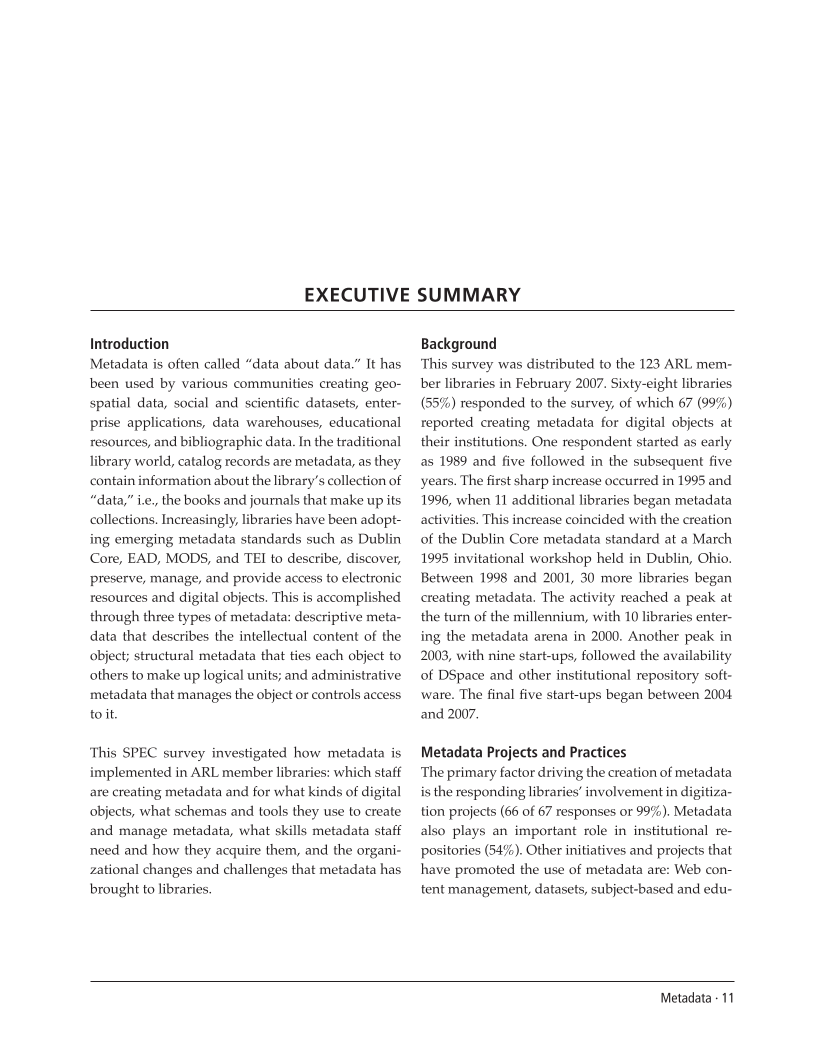Metadata · 11
Executive Summary
Introduction
Metadata is often called “data about data.” It has
been used by various communities creating geo-
spatial data, social and scientific datasets, enter-
prise applications, data warehouses, educational
resources, and bibliographic data. In the traditional
library world, catalog records are metadata, as they
contain information about the library’s collection of
“data,” i.e., the books and journals that make up its
collections. Increasingly, libraries have been adopt-
ing emerging metadata standards such as Dublin
Core, EAD, MODS, and TEI to describe, discover,
preserve, manage, and provide access to electronic
resources and digital objects. This is accomplished
through three types of metadata: descriptive meta-
data that describes the intellectual content of the
object structural metadata that ties each object to
others to make up logical units and administrative
metadata that manages the object or controls access
to it.
This SPEC survey investigated how metadata is
implemented in ARL member libraries: which staff
are creating metadata and for what kinds of digital
objects, what schemas and tools they use to create
and manage metadata, what skills metadata staff
need and how they acquire them, and the organi-
zational changes and challenges that metadata has
brought to libraries.
Background
This survey was distributed to the 123 ARL mem-
ber libraries in February 2007. Sixty-eight libraries
(55%) responded to the survey, of which 67 (99%)
reported creating metadata for digital objects at
their institutions. One respondent started as early
as 1989 and five followed in the subsequent five
years. The first sharp increase occurred in 1995 and
1996, when 11 additional libraries began metadata
activities. This increase coincided with the creation
of the Dublin Core metadata standard at a March
1995 invitational workshop held in Dublin, Ohio.
Between 1998 and 2001, 30 more libraries began
creating metadata. The activity reached a peak at
the turn of the millennium, with 10 libraries enter-
ing the metadata arena in 2000. Another peak in
2003, with nine start-ups, followed the availability
of DSpace and other institutional repository soft-
ware. The final five start-ups began between 2004
and 2007.
Metadata Projects and Practices
The primary factor driving the creation of metadata
is the responding libraries’ involvement in digitiza-
tion projects (66 of 67 responses or 99%). Metadata
also plays an important role in institutional re-
positories (54%). Other initiatives and projects that
have promoted the use of metadata are: Web con-
tent management, datasets, subject-based and edu-
Executive Summary
Introduction
Metadata is often called “data about data.” It has
been used by various communities creating geo-
spatial data, social and scientific datasets, enter-
prise applications, data warehouses, educational
resources, and bibliographic data. In the traditional
library world, catalog records are metadata, as they
contain information about the library’s collection of
“data,” i.e., the books and journals that make up its
collections. Increasingly, libraries have been adopt-
ing emerging metadata standards such as Dublin
Core, EAD, MODS, and TEI to describe, discover,
preserve, manage, and provide access to electronic
resources and digital objects. This is accomplished
through three types of metadata: descriptive meta-
data that describes the intellectual content of the
object structural metadata that ties each object to
others to make up logical units and administrative
metadata that manages the object or controls access
to it.
This SPEC survey investigated how metadata is
implemented in ARL member libraries: which staff
are creating metadata and for what kinds of digital
objects, what schemas and tools they use to create
and manage metadata, what skills metadata staff
need and how they acquire them, and the organi-
zational changes and challenges that metadata has
brought to libraries.
Background
This survey was distributed to the 123 ARL mem-
ber libraries in February 2007. Sixty-eight libraries
(55%) responded to the survey, of which 67 (99%)
reported creating metadata for digital objects at
their institutions. One respondent started as early
as 1989 and five followed in the subsequent five
years. The first sharp increase occurred in 1995 and
1996, when 11 additional libraries began metadata
activities. This increase coincided with the creation
of the Dublin Core metadata standard at a March
1995 invitational workshop held in Dublin, Ohio.
Between 1998 and 2001, 30 more libraries began
creating metadata. The activity reached a peak at
the turn of the millennium, with 10 libraries enter-
ing the metadata arena in 2000. Another peak in
2003, with nine start-ups, followed the availability
of DSpace and other institutional repository soft-
ware. The final five start-ups began between 2004
and 2007.
Metadata Projects and Practices
The primary factor driving the creation of metadata
is the responding libraries’ involvement in digitiza-
tion projects (66 of 67 responses or 99%). Metadata
also plays an important role in institutional re-
positories (54%). Other initiatives and projects that
have promoted the use of metadata are: Web con-
tent management, datasets, subject-based and edu-














































































































































































